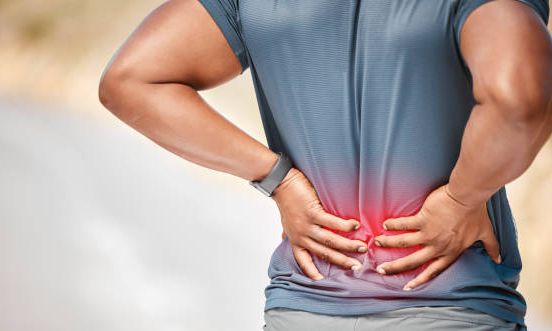B. Jeffrey Jolley, D.C., D.A.C.N.B.
Living with back pain, especially from a herniated disc, can be frustrating and limiting. While medical care is essential, there are many effective self-care strategies you can use at home to ease discomfort, improve mobility, and support recovery. Below are safe, practical methods you can start today.
1. Positioning & Rest
Finding the right position can ease spinal pressure and reduce pain:
- Limit bed rest - short rest is fine during flare-ups, but gentle movement helps healing and limits spinal deconditioning.
- Best positions for pain relief:
- On your back with a pillow under your knees.
- On your side with a pillow between knees and ankles.
- Avoid soft couches or low seats. Use a firm chair with lumbar support.
2. Heat & Ice Therapy
Alternating heat and cold can calm pain and inflammation:
- Ice packs: 20-30 minutes every 2 hours during the first 24-48 hours of a flare-up or longer to help manage the pain (if you are sensitive to ice you can use a towel as a barrier). Never put a chemical cold pack directly on your skin.
- Heat therapy: After the pain becomes manageable, try warm showers or a heating pad to relax muscles and increase circulation.
3. Gentle Exercises & Stretches
Movement is crucial for recovery but stop immediately if the pain worsens.
McKenzie Extension (Prone Press-Up):
- Lie face down.
- Start with elbows under shoulders (sphinx pose), hold 20-30 seconds, repeat 5x.
- Progression: Place hands under shoulders and gently press up, keeping hips on the floor. Hold 10 seconds, repeat 5 reps. Only continue if the pain is improving or the leg pain moves upward (centralizes) towards the spine. If the pain increases in the back or leg in any way stop immediately!!
- Do 2-3 times daily, especially if sitting worsens pain.
Other Gentle Options:
- Pelvic tilts - strengthen core support.
- Knee-to-chest stretch - ease lower back tension.
- Cat-cow stretch - improve spine mobility.
- Short walks - 5-10 minutes several times daily.
4. Smart Daily Habits
Small adjustments prevent strain and protect your spine:
- Avoid heavy lifting; if needed, bend at the knees not the waist.
- Limit twisting and deep forward bends.
- Wear supportive shoes (avoid high heels and flimsy flats).
- Set up ergonomically: screen at eye level, feet flat, knees slightly higher than hips.
- Take a posture break every 30-60 minutes when sitting.
5. Over-the-Counter Relief
Helpful options for managing pain at home:
- NSAIDs (ibuprofen, naproxen) - reduce inflammation (if safe for you).
- Topicals with menthol, lidocaine, or capsaicin - ease muscle soreness.
6. Lifestyle Support
Long-term habits keep your back strong and healthy:
- Stay hydrated - discs need water to stay cushioned.
- Manage weight gently - reduces spinal load.
- Prioritize quality sleep - supportive mattress and consistent routine.
- Build core strength - add gentle core exercises (like bridges or modified planks) later in recovery.
Final Thoughts
These self-care strategies won’t “cure” a herniated disc, but they can ease pain, restore mobility, and support recovery during flare-ups.
Seek medical attention immediately if you experience worsening pain, weakness, numbness, or loss of bladder/bowel control.
Consistency matters! By combining movement, rest, and healthy habits, you can take meaningful control of your back health.
At The Center for Total Back Care, we offer a comprehensive disc management program designed to address herniated discs non-surgically and provide lasting relief from low back and leg pain.
Call us today at (480) 633-8293 or visit www.totalback.com to schedule a consultation and learn how we can help.
